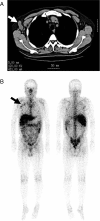Erythropoietin-producing tubercle granuloma in a hemodialysis patient
- PMID: 23601138
- PMCID: PMC3646680
- DOI: 10.1186/1471-2369-14-91
Erythropoietin-producing tubercle granuloma in a hemodialysis patient
Abstract
Background: We describe a case of a fever of unknown etiology that was caused by a caseating tubercle granuloma which produced erythropoietin. To our knowledge, this is the first report of an erythropoietin- producing granuloma.
Case presentation: A 48-year-old Japanese man with a 5-year history of maintenance hemodialysis for diabetic nephropathy presented with an intermittent fever over a few months. During febrile periods he developed erythema nodosum on his legs. Computed tomography showed axillary lymph node enlargement and this was further corroborated by a gallium scan that revealed high gallium uptake in these nodes. A Mantoux test was positive and an interferongamma release assay for tuberculosis diagnosis was also positive. Lymph node tuberculosis was suspected and the patient underwent lymphadenectomy. Histological analysis of the lymph nodes revealed a caseating granuloma that showed positive results on an acid-fast bacteria stain and a Mycobacterium tuberculosis polymerase chain reaction test. After lymphadenectomy, however, the patient's hemoglobin levels rapidly decreased from 144 to 105 g/L, and this was further compounded by a decrease in serum erythropoietin from 223 mIU/mL to 10.7 mIU/mL by postoperative day 21. We suspected the tubercle to be a source of the erythropoietin and this was further confirmed by in situ hybridization.
Conclusions: We report for the first time ectopic erythropoietin production by a tuberculous lymph node. Our observations are substantiated by a postoperative decline in his erythropoietin level and a clinical requirement for erythropoietin treatment.
Figures



Similar articles
-
Unusual presentations of extrapulmonary tuberculosis in three hemodialysis patients.Ren Fail. 1997 May;19(3):485-90. doi: 10.3109/08860229709047735. Ren Fail. 1997. PMID: 9154666
-
[A case of Poncet's disease (tuberculous rheumatism) in a patient with chronic renal failure undergoing hemodialysis therapy].Ryumachi. 2003 Oct;43(4):678-82. Ryumachi. 2003. PMID: 14598662 Japanese.
-
Necrotising granulomatous lymphadenitis.BMJ Case Rep. 2011 Feb 8;2011:bcr1120103548. doi: 10.1136/bcr.11.2010.3548. BMJ Case Rep. 2011. PMID: 22715187 Free PMC article.
-
Granuloma inguinale of cervical lymph nodes simulating tuberculous lymphadenitis: two case reports and review of published reports.Genitourin Med. 1988 Oct;64(5):339-43. doi: 10.1136/sti.64.5.339. Genitourin Med. 1988. PMID: 3060425 Free PMC article. Review.
-
Application of endobronchial ultrasound-guided transbronchial needle aspiration in the diagnosis and treatment of mediastinal lymph node tuberculous abscess: a case report and literature review.J Cardiothorac Surg. 2020 Nov 23;15(1):331. doi: 10.1186/s13019-020-01360-3. J Cardiothorac Surg. 2020. PMID: 33225977 Free PMC article. Review.
Cited by
-
Sensitivity of Immunodiagnostic Tests in Localized Versus Disseminated Tuberculosis-A Systematic Review of Individual Patient Data.Trop Med Infect Dis. 2025 Mar 7;10(3):70. doi: 10.3390/tropicalmed10030070. Trop Med Infect Dis. 2025. PMID: 40137824 Free PMC article. Review.
References
-
- Sakisaka S, Watanabe M, Tateishi H, Harada M, Shakado S, Mimura Y, Gondo K, Yoshitake M, Noguchi K, Hino T. Erythropoietin production in hepatocellular carcinoma cells associated with polycythemia: immunohistochemical evidence. Hepatology. 1993;18(6):1357–1362. doi: 10.1002/hep.1840180612. - DOI - PubMed
-
- Nielsen OJ, Jespersen FF, Hilden M. Erythropoietin-induced secondary polycythemia in a patient with a renal cell carcinoma. A case report. APMIS. 1988;96(8):688–694. - PubMed
Publication types
MeSH terms
Substances
LinkOut - more resources
Full Text Sources
Other Literature Sources
Medical

